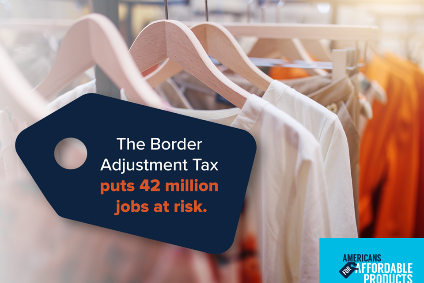Donald Trump has taken office as U.S. President. It’s time to move beyond campaign rhetoric and vague talk of “trade war” to consider specific policies. There are many options for the new administration in pursuing what some see as a much-needed overhaul of U.S.-China trade. One has been laid out in some detail and has the strong support of Republican leadership in the House of Representatives: a border adjustment tax.

Campaigners calculate the Border Adjustment Tax would lead to American families paying $1,700 more each year for clothes, food, and everyday essentials. (2017, Just-Style)
The border adjustment tax (BAT) is just one part of a broad proposal for tax reform. Both the proposal as a whole and the BAT in particular have pluses and minuses. Modification or rejection of the proposed BAT is entirely possible. President Trump’s view of the House leadership’s BAT has fluctuated but he has said clearly that some form of border tax is coming. At time of writing, the BAT is the leading candidate for fundamental, rather than just incremental, change in U.S. trade policy.
The BAT modifies the 20 percent business cash flow tax in the broader reform plan by not allowing companies to deduct imports. Exports, meanwhile, can be tax free even as exporters also claim deductions available to companies which do not trade. The tax benefits for exporters may be modified but the effective result will remain: to subsidize American labor as compared to the current system.
A superior option along these lines would be reducing the payroll tax but this is politically dangerous. The proposed BAT is not as controversial, helps American workers, and offers revenue to a Congress that wants both spending increases and tax cuts elsewhere. Estimates for BAT revenue range as high as $1.2 trillion. The final tally will be lower, but this remains a hefty incentive to vote yes.
One effect of the BAT will be to push up the value of the dollar. The dollar’s value will not rise fully to offset the BAT because real-world exchange rates do not perform as abstract models indicate. For example, countries like China intervene to oppose market-dictated adjustments. However, the dollar may already have risen in part in response to the possibility of a BAT. If one is enacted, the dollar will rise substantially and limit changes in the U.S. trade balance.
The BAT can be discussed at length without mentioning China. It is not aimed at China specifically. But China is nonetheless at or near the heart of the matter. Since China is the largest source of American imports, the BAT would have the largest impact on China of any U.S. partner. Since China is by far the largest cause of America’s trade imbalance, the BAT draws support in part as a response to predatory Chinese trade practices.
It typically goes unremarked but direct Sino-American merchandise trade is slipping a bit. Among other things, this is a reminder that it will be difficult to determine the effects of a BAT in isolation, especially as the dollar moves. As a result of the BAT, American exports to China could increase over time by close to $15 billion and imports from China could drop approximately $70 billion from the current baseline. This of course depends on the strength of the two economies and new policies, include trade responses from Beijing.
Those responses may not be too strident. A BAT does not single out China, its generality makes it more of an internal American matter than a bilateral issue. This is probably the single most important feature in Beijing’s eyes. The Trump administration may consider a BAT inferior to a series of sector-tariffs on steel, auto parts, and so on. This would come closer to targeting China and could do so explicitly. Even if the sanctions themselves are less disruptive, being named in this fashion might oblige Beijing to stronger retaliation.
Another factor in China’s response is imitation: will other countries copy the American action? For sector tariffs, this is likely, both because the U.S. blazed the trail and due to fear of a flood of Chinese goods being diverted from a closed American market. In the case of a BAT, most countries already apply a close approximation - a value-added tax. These could be tweaked but a flood of new trade barriers aimed at China is unlikely to follow from an American BAT.
Another reason Beijing might not respond directly to the BAT is also a reason Washington might not adopt one: it may be judged as breaking the rules of the World Trade Organization (WTO). Value-added taxes are accepted by the WTO, if for perhaps dubious reasons. The proposed form of the BAT is economically equivalent to a value-added tax but it is not legally equivalent.
The difference is small enough that the WTO is not obliged to rule against a BAT and may feel pressured not to do so if the reform turns out to have strong American political support. Or the WTO may force the U.S. to choose between modifying its tax reform or facing retaliation. Either way, Beijing has the option of outsourcing its response, joining a multi-country WTO case and accepting the decision.
What China would do in response to what the U.S. could do is highly speculative. However, there is a clear principle as to what both should do. Large economies should focus on domestic policy, treating trade as the secondary factor it is. The full American tax reform is an enormous topic, but its impact at home is what matters, not whether the trade deficit barrows. Similarly, Beijing will respond forcefully to anything like a 35% across-the-board tariff aimed only at China. But in the case of the current BAT, China is best served by focusing on fixing its own house.


